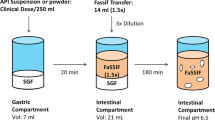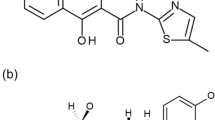Abstract
Background and Objectives
The US Food and Drug Administration, World Health Organization and European Medicines Agency have allowed biowaiver for some BCS class III drugs, but shortened the requisite dissolution time of BCS class III drugs from 30 to 15 min, considering their site-specific absorption and others risk. The objective of this study was to assess the effects of site-specific absorption, low absorbed fraction (F a) and gastric emptying rate on the biowaiver extension of BCS class III drugs.
Methods
The oral absorption of BCS class III drugs nadolol, acebutolol and atenolol which were P-gp substrates, was simulated using GastroPlus software with physiological parameters reflecting site-specific and site-independent absorption. Then, the simulation results were compared with the experimental data in literature. Simulation with different dissolution rates (>85 % solubility, T 85 % = 15–180 min) was performed to predict absorption (maximum concentration, C max and area under the concentration-time curve from time 0 to infinity, AUC0–inf) of the above model/virtual drugs (F a 3.81–80.14 %).
Results
The results of this study indicated that the site-specific absorption and low F a magnified the effect of dissolution rate on C max and AUC0–inf. However, the oral absorption of model drugs was not sensitive to the change of gastric emptying rate from 0.1, 0.25, 0.5 to 1 h.
Conclusions
Based on the results of this study, we suggest that for BCS class III drug with high F a (about >80 %), the biowaiver should extend to rapid dissolution (T 85 % = 30 min), and 30 % of F a as the boundary of intermediate permeability class (30 % < F a < 85 %).









Similar content being viewed by others
References
Guideline on the investigation of bioequivalence. EMA; 2010. http://www.ema.europa.eu/docs/en_GB/document_library/Scientific_guideline/2010/01/WC500070039.pdf. Accessed 21 July 2016.
Amidon GL, Lennernas H, Shah VP, Crison JR. A theoretical basis for a biopharmaceutic drug classification: the correlation of in vitro drug product dissolution and in vivo bioavailability. Pharm Res. 1995;12(3):413–20.
Lobenberg R, Amidon GL. Modern bioavailability, bioequivalence and biopharmaceutics classification system. New scientific approaches to international regulatory standards. Eur J Pharm Biopharm. 2000;50(1):3–12.
Guidance for industry: Waiver of in vivo bioavailability and bioequivalence studies for immediate-release solid oral dosage forms based on a biopharmaceutics classification system. FDA; 2015. http://www.fda.gov/downloads/Drugs/.../Guidances/ucm070246.pdf. Accessed 21 July 2016.
Proposal to waive in vivo bioequivalence requirements for the WHO model list of essential medicines immediate release, solid oral dosage forms. WHO; 2005. http://www.who.int/medicines/services/expertcommittees/pharmprep/QAS04_109Rev1_Waive_invivo_bioequiv.pdf. Accessed 21 July 2016.
Lee VH. Membrane transporters. Eur J Pharm Sci. 2000;11(Suppl 2):S41–50.
Suzuki H, Sugiyama Y. Role of metabolic enzymes and efflux transporters in the absorption of drugs from the small intestine. Eur J Pharm Sci. 2000;12(1):3–12.
Drozdzik M, Groer C, Penski J, Lapczuk J, Ostrowski M, Lai Y, et al. Protein abundance of clinically relevant multidrug transporters along the entire length of the human intestine. Mol Pharm. 2014;11(10):3547–55. doi:10.1021/mp500330y.
Oswald S, Groer C, Drozdzik M, Siegmund W. Mass spectrometry-based targeted proteomics as a tool to elucidate the expression and function of intestinal drug transporters. AAPS J. 2013;15(4):1128–40. doi:10.1208/s12248-013-9521-3.
Mouly S, Paine MF. P-glycoprotein increases from proximal to distal regions of human small intestine. Pharm Res. 2003;20(10):1595–9.
Dave MH, Schulz N, Zecevic M, Wagner CA, Verrey F. Expression of heteromeric amino acid transporters along the murine intestine. J Physiol. 2004;558(Pt 2):597–610. doi:10.1113/jphysiol.2004.065037.
Yu LX, Amidon GL, Polli JE, Zhao H, Mehta MU, Conner DP, et al. Biopharmaceutics classification system: the scientific basis for biowaiver extensions. Pharm Res. 2002;19(7):921–5.
Polli JE, Abrahamsson BS, Yu LX, Amidon GL, Baldoni JM, Cook JA, et al. Summary workshop report: bioequivalence, biopharmaceutics classification system, and beyond. AAPS J. 2008;10(2):373–9. doi:10.1208/s12248-008-9040-9.
Blume HH, Schug BS. The biopharmaceutics classification system (BCS): class III drugs—better candidates for BA/BE waiver? Eur J Pharm Sci. 1999;9(2):117–21.
Tsume Y, Amidon GL. The biowaiver extension for BCS class III drugs: the effect of dissolution rate on the bioequivalence of BCS class III immediate-release drugs predicted by computer simulation. Mol Pharm. 2010;7(4):1235–43. doi:10.1021/mp100053q.
Kortejarvi H, Urtti A, Yliperttula M. Pharmacokinetic simulation of biowaiver criteria: the effects of gastric emptying, dissolution, absorption and elimination rates. Eur J Pharm Sci. 2007;30(2):155–66.
Cheng CL, Yu LX, Lee HL, Yang CY, Lue CS, Chou CH. Biowaiver extension potential to BCS Class III high solubility-low permeability drugs: bridging evidence for metformin immediate-release tablet. Eur J Pharm Sci. 2004;22(4):297–304. doi:10.1016/j.ejps.2004.03.016.
Jantratid E, Prakongpan S, Amidon GL, Dressman JB. Feasibility of biowaiver extension to biopharmaceutics classification system class III drug products: cimetidine. Clin Pharmacokinet. 2006;45(4):385–99.
Homsek I, Parojcic J, Dacevic M, Petrovic L, Jovanovic D. Justification of metformin hydrochloride biowaiver criteria based on bioequivalence study. Arzneimittelforschung. 2010;60(9):553–9. doi:10.1055/s-0031-1296324.
Database: drugbank. http://www.drugbank.ca/. Accessed 21 July 2016.
Arnal J, Gonzalez-Alvarez I, Bermejo M, Amidon GL, Junginger HE, Kopp S, et al. Biowaiver monographs for immediate release solid oral dosage forms: aciclovir. J Pharm Sci. 2008;97(12):5061–73. doi:10.1002/jps.21392.
Meier J. Pharmacokinetic comparison of pindolol with other beta-adrenoceptor-blocking agents. Am Heart J. 1982;104(2 Pt 2):364–73.
Agoram B, Woltosz WS, Bolger MB. Predicting the impact of physiological and biochemical processes on oral drug bioavailability. Adv Drug Deliv Rev. 2001;50(Suppl 1):S41–67.
Yang Y, Faustino PJ, Volpe DA, Ellison CD, Lyon RC, Yu LX. Biopharmaceutics classification of selected beta-blockers: solubility and permeability class membership. Mol Pharm. 2007;4(4):608–14. doi:10.1021/mp070028i.
Morrison RA, Singhvi SM, Creasey WA, Willard DA. Dose proportionality of nadolol pharmacokinetics after intravenous administration to healthy subjects. Eur J Clin Pharmacol. 1988;33(6):625–8.
Srinivas NR, Barr WH, Shyu WC, Mohandoss E, Chow S, Staggers J, et al. Bioequivalence of two tablet formulations of nadolol using single and multiple dose data: assessment using stereospecific and nonstereospecific assays. J Pharm Sci. 1996;85(3):299–303. doi:10.1021/js950442m.
Meffin PJ, Winkle RA, Peters FA, Harrison DC. Acebutolol disposition after intravenous administration. Clin Pharmacol Ther. 1977;22(5 Pt 1):557–67.
Kaye CM, Kumana CR, Leighton M, Hamer J, Turner P. Observations on the pharmacokinetics of acebutolol. Clin Pharmacol Ther. 1976;19(4):416–20.
Lilja JJ, Raaska K, Neuvonen PJ. Effects of grapefruit juice on the pharmacokinetics of acebutolol. Br J Clin Pharmacol. 2005;60(6):659–63. doi:10.1111/j.1365-2125.2005.02489.x.
Krukemyer JJ, Boudoulas H, Binkley PF, Lima JJ. Comparison of single-dose and steady-state nadolol plasma concentrations. Pharm Res. 1990;7(9):953–6.
Roux A, Le Liboux A, Delhotal B, Gaillot J, Flouvat B. Pharmacokinetics in man of acebutolol and hydrochlorothiazide as single agents and in combination. Eur J Clin Pharmacol. 1983;24(6):801–6.
Najib NM, Idkaidek N, Adel A, Mohammed B, Al-Masri S, Admour I, et al. Comparative bioavailability of two brands of atenolol 100 mg tablets (Tensotin and Tenormin) in healthy human volunteers. Biopharm Drug Dispos. 2005;26(1):1–5. doi:10.1002/bdd.416.
Lennernas H. Intestinal permeability and its relevance for absorption and elimination. Xenobiotica. 2007;37(10–11):1015–51. doi:10.1080/00498250701704819.
Yazdanian M, Briggs K, Jankovsky C, Hawi A. The, “high solubility” definition of the current FDA Guidance on Biopharmaceutical Classification System may be too strict for acidic drugs. Pharm Res. 2004;21(2):293–9.
Fischer SM, Brandl M, Fricker G. Effect of the non-ionic surfactant Poloxamer 188 on passive permeability of poorly soluble drugs across Caco-2 cell monolayers. Eur J Pharm Biopharm. 2011;79(2):416–22. doi:10.1016/j.ejpb.2011.04.010.
Terao T, Hisanaga E, Sai Y, Tamai I, Tsuji A. Active secretion of drugs from the small intestinal epithelium in rats by P-glycoprotein functioning as an absorption barrier. J Pharm Pharmacol. 1996;48(10):1083–9.
Cattoor K, Bracke M, Deforce D, De Keukeleire D, Heyerick A. Transport of hop bitter acids across intestinal Caco-2 cell monolayers. J Agric Food Chem. 2010;58(7):4132–40. doi:10.1021/jf904079h.
Dahan A, Amidon GL. Segmental dependent transport of low permeability compounds along the small intestine due to P-glycoprotein: the role of efflux transport in the oral absorption of BCS class III drugs. Mol Pharm. 2009;6(1):19–28. doi:10.1021/mp800088f.
Okabe T, Terashima H, Sakamoto A. Determinants of liquid gastric emptying: comparisons between milk and isocalorically adjusted clear fluids. Br J Anaesth. 2015;114(1):77–82. doi:10.1093/bja/aeu338.
Heading RC, Nimmo J, Prescott LF, Tothill P. The dependence of paracetamol absorption on the rate of gastric emptying. Br J Pharmacol. 1973;47(2):415–21.
Abuasal BS, Bolger MB, Walker DK, Kaddoumi A. In silico modeling for the nonlinear absorption kinetics of UK-343,664: a P-gp and CYP3A4 substrate. Mol Pharm. 2012;9(3):492–504. doi:10.1021/mp200275j.
Neuhoff S, Yeo KR, Barter Z, Jamei M, Turner DB, Rostami-Hodjegan A. Application of permeability-limited physiologically-based pharmacokinetic models: part I-digoxin pharmacokinetics incorporating P-glycoprotein-mediated efflux. J Pharm Sci. 2013;102(9):3145–60. doi:10.1002/jps.23594.
Darwich AS, Pade D, Rowland-Yeo K, Jamei M, Asberg A, Christensen H, et al. Evaluation of an in silico PBPK post-bariatric surgery model through simulating oral drug bioavailability of atorvastatin and cyclosporine. CPT Pharmacomet Syst Pharmacol. 2013;2:e47. doi:10.1038/psp.2013.23.
Valenzuela B, Nacher A, Ruiz-Carretero P, Martin-Villodre A, Lopez-Carballo G, Barettino D. Profile of P-glycoprotein distribution in the rat and its possible influence on the salbutamol intestinal absorption process. J Pharm Sci. 2004;93(6):1641–8. doi:10.1002/jps.20071.
Stephens RH, Tanianis-Hughes J, Higgs NB, Humphrey M, Warhurst G. Region-dependent modulation of intestinal permeability by drug efflux transporters: in vitro studies in mdr1a(−/−) mouse intestine. J Pharmacol Exp Ther. 2002;303(3):1095–101. doi:10.1124/jpet.102.041236.
Masaoka Y, Tanaka Y, Kataoka M, Sakuma S, Yamashita S. Site of drug absorption after oral administration: assessment of membrane permeability and luminal concentration of drugs in each segment of gastrointestinal tract. Eur J Pharm Sci. 2006;29(3–4):240–50. doi:10.1016/j.ejps.2006.06.004.
Author information
Authors and Affiliations
Corresponding authors
Ethics declarations
Funding
We thank National basic scientific talent training fund projects (No. J1103606), and Technology bureau in Shenyang (No. ZCJJ2013402). We also thank financial support from Project for New Century Excellent Talents of Ministry of Education (No. NCET-12-1015) and the financial support from Doctor start-up foundation of Liaoning Province (No. 20141031).
Conflicts of interest
Le Sun, Jin Sun and Zhonggui He declare no conflicts of interest.
Rights and permissions
About this article
Cite this article
Sun, L., Sun, J. & He, Z. Exploring the Feasibility of Biowaiver Extension of BCS Class III Drugs with Site-Specific Absorption Using Gastrointestinal Simulation Technology. Eur J Drug Metab Pharmacokinet 42, 471–487 (2017). https://doi.org/10.1007/s13318-016-0361-2
Published:
Issue Date:
DOI: https://doi.org/10.1007/s13318-016-0361-2




